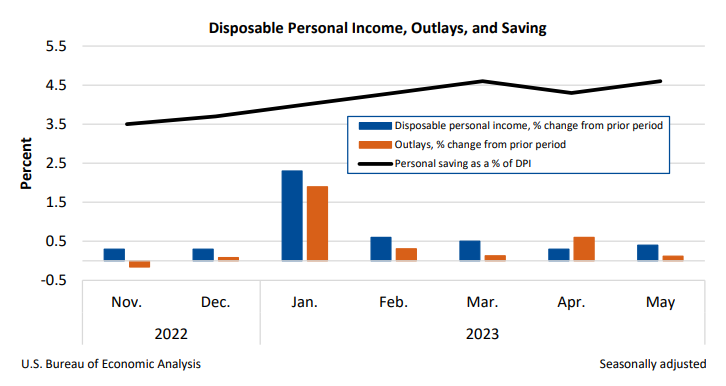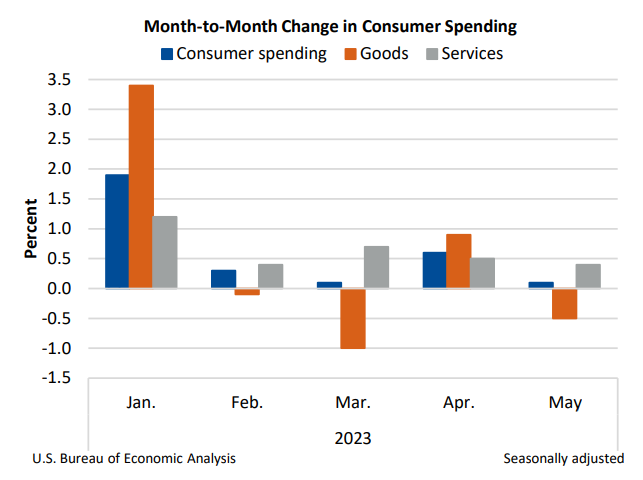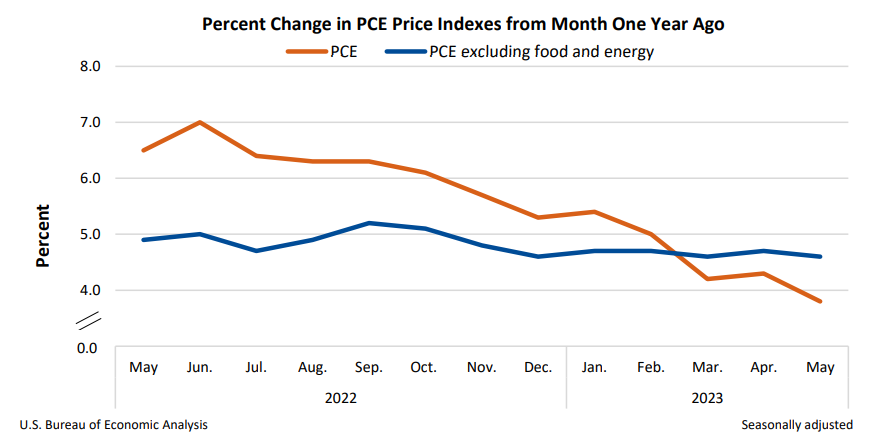Personal income increased $91.2 billion (0.4 percent at a monthly rate) in May. Disposable personal income —personal income less personal current taxes— increased $86.7 billion (0.4 percent). Personal outlays—the sum of personal consumption expenditures, personal interest payments, and personal current transfer payments—increased $22.7 billion (0.1 percent) and consumer spending increased $18.9 billion (0.1 percent). Personal saving was $910.3 billion and the personal saving rate—personal saving as a percentage of disposable personal income—was 4.6 percent in May.
- Within compensation, the increase was led by private wages and salaries, based on data from the Bureau of Labor Statistics (BLS) Current Employment Statistics (CES). Services-producing industries increased $42.6 billion and goods-producing industries increased $10.6 billion.
- The increase in personal current transfer receipts was led by an increase in Medicaid.
- The increase in personal income receipts on assets was led by personal interest income.
Consumer spending
The $18.9 billion increase in consumer spending in May reflected an increase in spending for services that was partly offset by a decrease in spending for goods.
- Within services, the largest contributors to the increase were health care (led by outpatient services), primarily reflecting BLS CES and price data; “other” services (led by international travel), based on international travelers data from the National Travel and Tourism Office; and transportation services (led by air transportation), based on Transportation Security Administration data on number of travelers.
- Within goods, the largest contributors to the decrease were motor vehicles and parts (led by new light trucks), based on unit sales data from Wards Intelligence, and gasoline and other energy goods (led by motor vehicle fuels, lubricants, and fluids), based on Energy Information Administration and BLS data.
PCE price index
From the preceding month, the personal consumption expenditures price index for May increased 0.1 percent. Food prices increased 0.1 percent and energy prices decreased 3.9 percent. Excluding food and energy, the PCE price index increased 0.3 percent. For a comparison of PCE prices to BLS consumer price indexes, refer to NIPA Table 9.1U. Reconciliation of Percent Change in the CPI with Percent Change in the PCE Price Index.
From the same month one year ago, the PCE price index for May increased 3.8 percent. Prices for goods increased 1.1 percent and prices for services increased 5.3 percent. Food prices increased 5.8 percent and energy prices decreased 13.4 percent. Excluding food and energy, the PCE price index increased 4.6 percent from one year ago.
Real disposable personal income and consumer spending
Real DPI increased 0.3 percent in May. Real consumer spending decreased less than 0.1 percent, reflecting a decrease in spending on goods of 0.4 percent that was partly offset by an increase in spending on services of 0.2 percent. Within goods, the largest contributor to the decrease was spending for motor vehicles and parts (led by new light trucks). Within services, the increase was led by spending for “other” services (led by international travel) and transportation services (led by air transportation).
For more information, read the full release.



